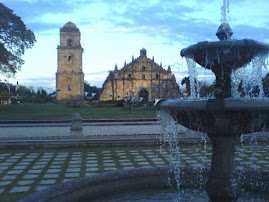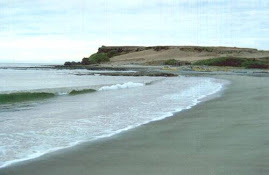‘Guling–Guling’
– mardi gras in Ilocandia!
By ETHEL S. TIMBOL
Manila Bulletin, 3/11/07
Guling–Guling, a little known tradition in Paoay, Ilocos Norte, heralds the Lenten Season just like the mardi gras of Rio de Janeiro and New Orleans.
According to lore, it was the Spanish friars that introduced the Guling–Guling in the 16th century, which they celebrated on the eve of Ash Wednesday. The festivity marked the last day when the townsfolk could make merry before the start of the somber Lenten season.
Guling–Guling comes from the Ilocano word meaning "to mark, to smear, or to make a sign." In the olden days, the chieftain or mayor would mark a person’s forehead with the sign of the cross using wet white rice flour. The color white (in contrast to grey ash) signified that the person marked with "guling" was cleansed of his sins.
The Guling–Guling is basically a street dance as the townsfolk, dressed in their best native attire, went out to the streets to dance. The women would wear the abel kimona and pandiling accessorized with flowers or with the family jewels. The men wore the camisa de chino and abel trousers.
The revellers would first have their foreheads marked with a "guling" by the mayor as a sign of good luck. The ritual was made festive with snacks of "binugbug, a native delicacy made of rice flour and sugar cane cooked in the "anawang," a crude oven made from dried sugarcane pulp.
The binugbug is washed down with gulps of the potent Ilocano spirits "basi" made from sugarcane extract and samak, a plant common in the Ilocos region. The brew would be fermented in "burnays", the famous Ilocano earthen jars to which was added samak leaves, bark and fruit.
Along the route of the parade, food hawkers would entice spectators with Ilocano snacks like the famous crispy "impanada", made of rice flour dough and stuffed with beansprouts, meat morsels and egg and dipped in vinegar with shalots (lasona) and spices … patopat (or impaltao), a suman made of sticky rice and boiled in molasses for two hours! … ditto, tupig, a hard pastilllas called linga, carioca rice flour balls or tinudok dipped in syrup, atbp. The American fastfoods just don’t stand a chance with snackers in Ilocandia.
Today, choreographers would be hired to coach the dance groups (barangays) to do the Pandanggo Paoayeña, the ariquenquen, curatsa, amorosa and La Jota Paoayeña with intricate steps and hand movements (kumintang).
This year, the board of judges was led by Paoay Mayor Bobby Clemente and Michael M. Keon, the son of the sister (Elizabeth Keon) of the late "Apo" Ferdie Marcos and chairman of the Tourism Development Council of Ilocos Norte. Among the judges also were Associate Justice Ccnchita Carpio Morales with her sister Marilou C. Claudio, Marie Respicio Gonzalez of the DoT Laoag office, et al.
The dancers, mostly led by lolas who have been dancing in the guling-guling since girlhood, executed their dances in varying formations on the cobbled street in front of the historic Paoay church.
Highlight of the parade was a giant "dodol," a grayish ube rice cake, five meters in diameter on a giant bilao carried on an open truck. The dudol reportedly took one sack of rice, 60 coconuts and the juice of 500 stalks of sugarcane to make.
Having tasted and relished varying cuisines across the world and all over the Philippines, we were delighted to take lessons in Ilocano dishes on this trip. Our first stop was at La Preciosa, a restaurant in Laoag started in the ‘50s by Preciosa Ablan Ventura Palma. Our host was Michael Keon who had invited our media group to Ilocos Norte to witness the Guling Guling.
We feasted on pinakbet, the old Ilocano favorite, which literally means to "wrinkle" the vegetables by overcooking it… poki poki, an eggplant omelet mixed with tomatoes, bagnet which is a tasty version of lechon kawali, dinengdeng or inabrao which means "to boil".
Other Ilocano dishes are sinanlao which we can only describe as a watered down batchoy… higado which is similar to but less spicy than bopis, popotlo, a seaweed salad (resembling green worms) found only in the region, and the exotic adobo of frogs legs.
The Ilocanos eat a lot of fresh fish and seafoods harvested from the waters of the South China sea surrounding the region and indeed, it was the Ilocanos that actually invented bagoong although Pangasinan is better known for producing it today.
Prior to the Guling–Guling we had lunch at La Herencia, newly opened across the Paoay church, and run by Samuel Blas who also owns a pensione called "Balay da Blas" in Laoag City. Here we sampled the crispy dinuguan which is a dry dinuguan mixed with bagnet, salads of bulaklak ng katuday, kamote tops, sigarilyas, kabatiti or patola, the tiny amalaya called parya, totong (tiny stringbeans), atbp.
As soon as we arrived in the Laoag airport on a Cebu Pacific flight, we took a detour to Bangui to see the windmills of the Northwind Power Development Corp. like giant electric fans powered by winds from the sea. The wind farm produces 25 megawatts or enough to supply 40 percent of the electricity needs of Ilocos Norte. Because the windmills harness wind, they do not produce greenhouse gases. Hopefully, this method of renewable energy will be replicated all over the Philippines.
On our way back to Laoag, we dropped by Pasuquin, famous for its saltmakers and also for biscocho (crispy bread) although only one family makes it, the Salmons of Pasuquin. Here we met Mang Phil Alvarez originally of Sariaya, Quezon, whose wife brought him to Pasuquin.
It always is wonderful to return to the Ilocos. My parents, the late Assemblyman Benito T. Soliven and Pelagia (nee Villaflor) Soliven hail from Sto. Domingo and Vigan in Ilocos Sur. Land travelers always pass by a monument to my dad in Sto. Domingo.
Now also, in my adopted probinsiya, Ilocos Norte, we have discovered Sitio Remedios, a heritage village created by my dear friend Dr. Joven Cuanang, medical director of St. Luke’s Medical Center, in Currimao, a couple of towns away from the boundary of Ilocos Sur. Let me tell you about it next time!
 Justice Conchita Carpio-Morales
Justice Conchita Carpio-Morales
 Notice the new cobbled street where the parade was held (below).
Notice the new cobbled street where the parade was held (below). Also on parade was the biggest Dudol ever made in Paoay. Everyone partook of it after the parade.
Also on parade was the biggest Dudol ever made in Paoay. Everyone partook of it after the parade.



















 Historians say: “From the date of early settlement to 1701, little could be said about the activities of the early settlers of Paoay except that much had been done in the clearing of the forests nearby. They converted the forests into rice and sugar lands through the slash-and-burn method called ‘kaingin.’ The early settlers were of a peace-loving tribe, but their major problem was the frequent furious incursions of Sea Rovers and Moro pirates called Tirong who looted indiscriminately their agricultural produce and other valuables. To protect themselves from further incursions, the folks moved towards the nearby inland where the present town proper is now located. In the farther western inland, there were also settlers who formed the neighboring town of Batac. Sensing that the Bombay people had suffered too much from the Moro raids, the people of Batac offered the people of Bombay to live with them. But the brave and maverick folks rejected the offer and instead they uttered "Maka-paoay kami" – an Ilocano dialect jargon meaning they could live independently. The settlers from Batac were offended and it was from this incident that the name of the town came to arrive as PAOAY.”
Historians say: “From the date of early settlement to 1701, little could be said about the activities of the early settlers of Paoay except that much had been done in the clearing of the forests nearby. They converted the forests into rice and sugar lands through the slash-and-burn method called ‘kaingin.’ The early settlers were of a peace-loving tribe, but their major problem was the frequent furious incursions of Sea Rovers and Moro pirates called Tirong who looted indiscriminately their agricultural produce and other valuables. To protect themselves from further incursions, the folks moved towards the nearby inland where the present town proper is now located. In the farther western inland, there were also settlers who formed the neighboring town of Batac. Sensing that the Bombay people had suffered too much from the Moro raids, the people of Batac offered the people of Bombay to live with them. But the brave and maverick folks rejected the offer and instead they uttered "Maka-paoay kami" – an Ilocano dialect jargon meaning they could live independently. The settlers from Batac were offended and it was from this incident that the name of the town came to arrive as PAOAY.” In 1571, when the Spanish conquistadors had Manila more or less under their control, they began looking for new sites to conquer. Legaspi's grandson, Juan de Salcedo, volunteered to lead one of these expeditions. Together with 8 armed boats and 45 men, the 22 year old voyager headed north.
In 1571, when the Spanish conquistadors had Manila more or less under their control, they began looking for new sites to conquer. Legaspi's grandson, Juan de Salcedo, volunteered to lead one of these expeditions. Together with 8 armed boats and 45 men, the 22 year old voyager headed north.
 Shown above are some of the antique furnishings of the cafe
Shown above are some of the antique furnishings of the cafe










